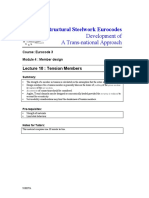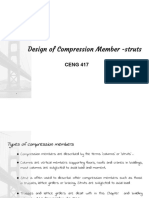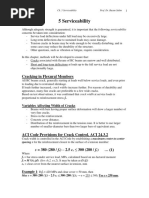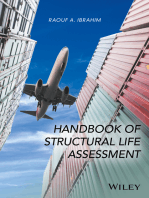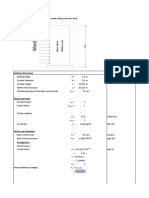Restrained Beams Handout
Restrained Beams Handout
Uploaded by
ikanyu79Copyright:
Available Formats
Restrained Beams Handout
Restrained Beams Handout
Uploaded by
ikanyu79Original Description:
Copyright
Available Formats
Share this document
Did you find this document useful?
Is this content inappropriate?
Copyright:
Available Formats
Restrained Beams Handout
Restrained Beams Handout
Uploaded by
ikanyu79Copyright:
Available Formats
Steel Design to Eurocode 3
Section Modulus, W
Restrained Beams
Subscripts are used to identify whether or not the
section modulus is plastic or elastic and the axis
about which it acts.
A beam is considered restrained if:
The section is bent about its minor axis
Full lateral restraint is provided
Closely spaced bracing is provided making
the slenderness of the weak axis low
The compressive flange is restrained again
torsion
The section has a high torsional and lateral
bending stiffness
There are a number of factors to consider when
designing a beam, and they all must be satisfied
for the beam design to be adopted:
Bending Moment Resistance
Shear Resistance
Combined Bending and Shear
Serviceability
Bending Moment
Resistance
In Eurocode 3:
Clause 6.2 covers the cross-sectional
resistance
o Clause 6.2.5 deals with the crosssectional resistance for bending.
EN 1993-1-1 Clause 6.2.4 Equation 6.12 states
that the design moment (MEd) must be less than
the design cross-sectional moment resistance
(Mc,Rd)
(6.12)
The equation to calculate Mc,Rd is dependent on
the class of the section. A detailed assessment of
cross-section classification can be found in the
Local Buckling and Cross-Section Classification
handout.
For Class 1 and 2 cross-sections:
Mc,Rd = Mpl,Rd = W plfy/M0(6.13)
For Class 3 cross-sections:
Mc,Rd = Mel,Rd = W el,minfy/M0
(6.14)
For Class 4 cross sections:
Mc,Rd = W eff,minfy/M0
M0 =1.0
(6.15)
BS
EC3
5950
Elastic modulus about the major axis
Zxx
W el,y
Elastic modulus about the minor axis
Zyy
W el,z
Plastic modulus about the major axis
Sxx
W pl,y
Plastic modulus about the minor axis
Syy
W pl,z
Table 1.0 Section modulus terminology comparison
between BS 5950 and EC3
Cross-section Classification
Summary
1. Get fy from Table 3.1
2. Get from Table 5.2
3. Substitute the value of into the class limits in
Table 5.2 to work out the class of the flange
and web
4. Take the least favourable class from the
flange outstand, web in bending and web in
compression results to get the overall section
class
Bending Moment Resistance
Summary
1. Determine the design moment, MEd
2. Choose a section and determine the section
classification
3. Determine Mc,Rd, using equation 6.13 for Class
1 and 2 cross-sections, equation 6.14 for
Class 3 cross-sections, and equation 6.15 for
Class 4 sections. Ensure that the correct
value of W, the section modulus is used.
4. Carry out the cross-sectional moment
resistance check by ensuring equation 6.12 is
satisfied.
Shear Resistance
In Eurocode 3:
Clause 6.2 covers the cross-sectional
resistance
o Clause 6.2.6 deals with the crosssectional resistance for shear.
EN 1993-1-1 Clause 6.2.6 Equation 6.17 states
that the design shear force (VEd) must be less than
the design plastic shear resistance of the crosssection (Vpl,Rd)
(6.17)
(6.18)
Shear Resistance Summary
1. Calculate the shear area, Av
M0 =1.0
2. Substitute the value of Av into equation 6.18
to get the design plastic shear resistance
Shear Area, Av
EC3 should provide a slightly larger shear area
compared to BS 5950 meaning that the overall
resistance will be larger as shown in Figure 1.
3. Carry out the cross-sectional plastic shear
resistance check by ensuring equation 6.17 is
satisfied.
Serviceability
Deflection checks should be made against
unfactored permanent actions and unfactored
variable actions.
Figure 1: Differences in shear area calculated using BS
5950 and EC3
Type of member
Shear Area, Av
Rolled I and H sections
(load parallel to web)
Rolled Channel sections
(load parallel to web)
Rolled PHS of uniform
thickness (load parallel to
depth)
CHS and tubes of uniform
thickness
Plates and solid bars
Av = A 2btf + (tw + 2r)tf
but hwtw
Av = A 2btf + (tw + r)tf
Av =Ah/(b+h)
Av =2A/
Av =A
Table 2.0: Shear area formulas
Term
A
b
h
hw
r
tf
tw
Definition
Cross-sectional area
Overall breadth
Overall depth
Depth of web
Root radius
Flange thickness
Web thickness (taken as the minimum value
is the web is not of constant thickness)
Constant which may be conservatively taken
as 1.0
Table 3.0: Shear area parameter descriptions
Figure 1: Visual definition
of the parameters used in
the shear area
calculation. (Source:
Blue Book)
Figure 2: Standard case deflections and corresponding
maximum deflection equations
The maximum deflection calculated must not
exceed the deflection limit. The deflection limits
are not given directly in Eurocode 3, instead,
reference must be made to the National Annex.
Design Situation
Deflection limit
Cantilever
Length/180
Beams carrying plaster of
other brittle finish
Other beams (except
purlins and sheeting rails)
Span/360
Span/200
To suit the characteristics
of particular cladding
Table 4.0: Vertical Deflection Limits from NA 2.23
Clause 7.2.1(1) B
Purlins and sheeting rails
You might also like
- Lecture 10.6.3: Shear Connection III: PreviousNo ratings yetLecture 10.6.3: Shear Connection III: Previous9 pages
- 4 Design of Copm Members - Struts Sept 2023No ratings yet4 Design of Copm Members - Struts Sept 202337 pages
- Lecture 4-2-2 - Design of Compression Members NewNo ratings yetLecture 4-2-2 - Design of Compression Members New47 pages
- Composite Structures Full Notes Part 3 PDFNo ratings yetComposite Structures Full Notes Part 3 PDF23 pages
- Design of Steel Structure - Steel Design Tension MembersNo ratings yetDesign of Steel Structure - Steel Design Tension Members24 pages
- Steelwork Design Chapter 3 - Steel Beams HKCodeNo ratings yetSteelwork Design Chapter 3 - Steel Beams HKCode37 pages
- Member Design: Member Design Follows The Requirements Given in BS EN 1993-1-1No ratings yetMember Design: Member Design Follows The Requirements Given in BS EN 1993-1-116 pages
- Member Design - SteelConstruction - InfoNo ratings yetMember Design - SteelConstruction - Info21 pages
- Design of Plate Girders As Per IS 800 2007-LSM - Unsupported - Latest80% (5)Design of Plate Girders As Per IS 800 2007-LSM - Unsupported - Latest30 pages
- Design of Laterally Restrained Beams: Theoretical BackgroundNo ratings yetDesign of Laterally Restrained Beams: Theoretical Background13 pages
- Chapter-4 Design of Column & Column BaseNo ratings yetChapter-4 Design of Column & Column Base26 pages
- Local Buckling: Classification of Cross SectionsNo ratings yetLocal Buckling: Classification of Cross Sections10 pages
- Chapter-3 Design For Compression Member - StrutNo ratings yetChapter-3 Design For Compression Member - Strut16 pages
- Advance Design - Bracing Members Design According To Eurocode 3No ratings yetAdvance Design - Bracing Members Design According To Eurocode 38 pages
- Continuous Beam Design With Moment Redistribution (CSA A23.3-14) PDFNo ratings yetContinuous Beam Design With Moment Redistribution (CSA A23.3-14) PDF35 pages
- Structural Steel Design to Eurocode 3 and AISC SpecificationsFrom EverandStructural Steel Design to Eurocode 3 and AISC SpecificationsNo ratings yet
- Composite Structures of Steel and Concrete: Beams, Slabs, Columns and Frames for BuildingsFrom EverandComposite Structures of Steel and Concrete: Beams, Slabs, Columns and Frames for BuildingsNo ratings yet
- Dynamic Damage and FragmentationFrom EverandDynamic Damage and FragmentationDavid Edward LambertNo ratings yet
- Stress in ASME Pressure Vessels, Boilers, and Nuclear ComponentsFrom EverandStress in ASME Pressure Vessels, Boilers, and Nuclear ComponentsNo ratings yet
- Design and Analysis of Composite Structures for Automotive Applications: Chassis and DrivetrainFrom EverandDesign and Analysis of Composite Structures for Automotive Applications: Chassis and DrivetrainNo ratings yet
- Wind Load Reaction Force Due To Wind Action From Stack Acting On The Fan DeckNo ratings yetWind Load Reaction Force Due To Wind Action From Stack Acting On The Fan Deck3 pages
- Equal Angle Design: Distance of Centre of GravityNo ratings yetEqual Angle Design: Distance of Centre of Gravity4 pages
- Reinforced Concrete Designers Handbook 10th Edition Reynolds Steedman 2 Part PrintNo ratings yetReinforced Concrete Designers Handbook 10th Edition Reynolds Steedman 2 Part Print7 pages
- Pad Footing Analysis and Design (Bs8110-1:1997)No ratings yetPad Footing Analysis and Design (Bs8110-1:1997)6 pages
- Single-Span Beam Analysis: Input Data: Beam DataNo ratings yetSingle-Span Beam Analysis: Input Data: Beam Data1 page







